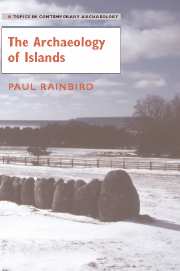Book contents
- Frontmatter
- Contents
- Figures
- Acknowledgments
- 1 A Consciousness of the Earth and Ocean: The Creation of Islands
- 2 Seas of Islands: Anthropology, Biogeography, Archaeology and Postcolonialism
- 3 An Archaeology of the Sea
- 4 The Mediterranean: Malta
- 5 Oceania: Pohnpei and the Eastern Carolines
- 6 The Baltic: Gotland
- 7 Atlantic Archipelago: The Western Seaways of Europe
- 8 Conclusion – Islands and Histories of the Sea
- References
- Index
2 - Seas of Islands: Anthropology, Biogeography, Archaeology and Postcolonialism
Published online by Cambridge University Press: 03 December 2009
- Frontmatter
- Contents
- Figures
- Acknowledgments
- 1 A Consciousness of the Earth and Ocean: The Creation of Islands
- 2 Seas of Islands: Anthropology, Biogeography, Archaeology and Postcolonialism
- 3 An Archaeology of the Sea
- 4 The Mediterranean: Malta
- 5 Oceania: Pohnpei and the Eastern Carolines
- 6 The Baltic: Gotland
- 7 Atlantic Archipelago: The Western Seaways of Europe
- 8 Conclusion – Islands and Histories of the Sea
- References
- Index
Summary
In this chapter, I will present the intellectual heritage of island archaeology derived from anthropology and biogeography and then move on to consider how the perspective of islanders themselves can help inform the archaeological study of islands. Through this exercise we are able to recognise the intellectual boundaries that can stifle the interpretation of island history and lead us to consider new ways of considering islands.
ISLANDS AND ANTHROPOLOGY
Charles Darwin's visit to the Galapágos Islands in 1835, aboard HMS Beagle, was to have a profound effect not only on evolutionary theory and natural history, but also on the development of the discipline of anthropology. The conclusion he drew from his observations was that animals and plants, long isolated from one another by being on an island, can evolve into new, separate species from what was originally a single species, what he called ‘speciation in isolation’. Darwin wrote of the chaffinches he saw:
When I see these Islands in sight of each other, and possessed of but a scanty stock of animals, tenanted by these birds, but slightly differing in structure and filling the same place in Nature, I must suspect they are only varieties. … If there is the slightest foundation for these remarks the Zoology of Archipelagos will be well worth examination; for such facts would undermine the stability of species.
(from Darwin's notebook, quoted in MacArthur and Wilson 1967: 3)The conclusion he drew helped establish the theory of evolution, for here was proof that plants and animals were not created and unchanging in their founding image, but if separated from one another in distinct breeding populations they would take divergent evolutionary paths.
- Type
- Chapter
- Information
- The Archaeology of Islands , pp. 26 - 45Publisher: Cambridge University PressPrint publication year: 2007



